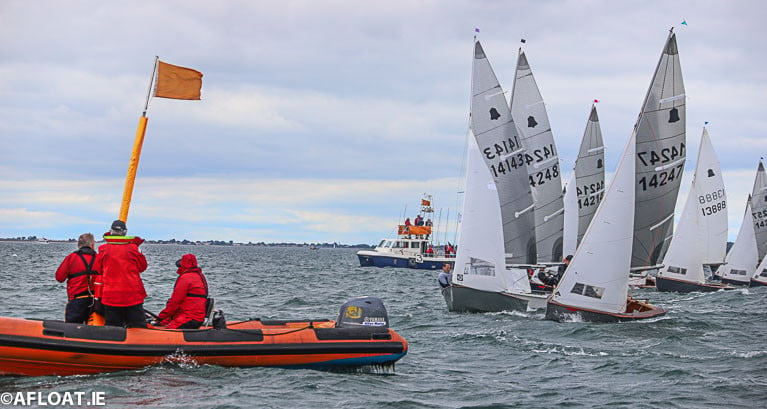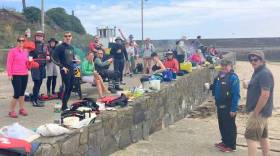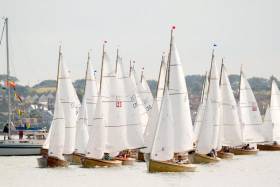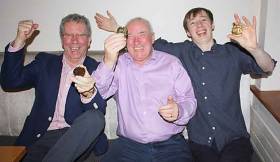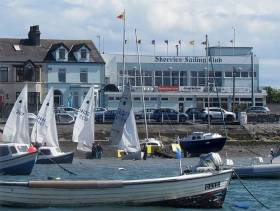Displaying items by tag: Skerries Sailing Club
A member of the 1983 America’s Cup winning crew has visited Skerries Sailing Club to follow a lead on a rare team flag that went missing when Australia II won the Auld Mug.
According to ABC News, the ‘boxing kangaroo’ flag was thought to have been secreted away from a support boat, the Black Swan, amid the celebrations in Newport, USA for John Bertrand and crew’s victory — and the United States’ first loss in the America’s Cup to that date.
The search for the missing flag picked up steam after a native of Bunbury, south of Perth and Fremantle in Western Australia, spotted the framed flag while at a wedding reception in Skerries SC.
Grayden Thompson recalled a speech given in Bunbury in 1983 by the Black Swan’s Newton Roberts in which the late deckhand lamented the loss of the flag — and subsequently learned of the local legend of its provenance.
Alas the ‘boxing kangaroo’ that Skerries has hosted since the 1980s is not the missing banner that’s flummoxed Australia’s sailing community for decades.
This was confirmed when Ken Judge, starboard trimmer on Australia II, travelled to the north Co Dublin sailing club to inspect the flag.
But it has sparked a mystery of its own, as its markings don’t match those of other commercially produced flags of the time — and it may even originate from the America’s Cup defence off Fremantle in 1987.
ABC News has more on the story HERE — and it’s also been covered by ABC Radio Darwin.
This story was updated to add a link to the radio segment.
Skerries Sailing Club was a hive of activity last weekend as 113 enthusiastic young sailors aged 8-15 gathered from all over Ireland for the second regional event on the 2022 IODAI circuit, the Optimist Leinster Championships.
The sailing club put on a great reception for sailors and parents alike. The all-important goodie bags, including T-Shirts and ice cream vouchers got the thumbs up from the whole fleet.
In the main fleet Race Officer Liam Dinneen and his team made the most of the steady 10-15 knot Northwesterlies by getting four races completed for both Junior and Senior Main Fleet Divisions on Saturday. Sunday threatened to be a day of even stronger Northerlies, but fortunately, the wind abated for a few hours allowing a full schedule of six races to be completed.
 The Irish Optimist fleet in action including UKR71 Photo: Anne Marie Hickey
The Irish Optimist fleet in action including UKR71 Photo: Anne Marie Hickey
A particular highlight of the weekend was the consistent series put together by talented Ukranian Sailor Sasha Bezpalyi sailing in his first regatta in Ireland.
In the Senior Main Gold Fleet Harry Dunne from Howth Yacht Club took 1st place, with Sasha (sailing with MYC) in 2nd place and Abigail Murphy from RSGYC in 3rd.
 Juliet Ryan won the Junior Main Gold Fleet Photo: Anne Marie Hickey
Juliet Ryan won the Junior Main Gold Fleet Photo: Anne Marie Hickey
In the Junior Main Fleet Gold Division, Juliet Ryan from Malahide Yacht Club was 1st, closely following by clubmate Patrick Fegan in 2nd place and Andrew Mannion from LRYC in 3rd place.
Meanwhile in the Regatta Fleet, Race Officer Kieran Branagan packed in 7 races across the two days. Aurele Dion from NYC put together an extremely consistent series to take 1st place ahead of Charlie McKibben Monkstown Bay Sailing Club and Jacob Browne from NYC.
 Aurele Dion 1st Place in Regatta Fleet Photo: Anne Marie Hickey
Aurele Dion 1st Place in Regatta Fleet Photo: Anne Marie Hickey
Skerries SC also had 11 local sailors competing and for many it was their first experience of a large regional regatta. It's hoped this will kickstart a Skerries Optimist Team that will take to the circuit later this year.
The event organisers are extremely appreciative for the support from their huge team of local volunteers, as well as the neighbouring sailing clubs and individuals who provided additional safety boats for the weekend.
 The Optimist fleet with Rockabill Lighthouse in the background Photo: Anne Marie Hickey
The Optimist fleet with Rockabill Lighthouse in the background Photo: Anne Marie Hickey
Skerries SC would also like to acknowledge the generous support from our sponsors including Fingal County Council, CraftInsure, Stoop Your Head Restaurant, Oakes Pharmacy, Med Account Services, Coco C and Colour Green Landscaping.
Next on the agenda for the Optimist fleet will be a trip west to Oranmore, Galway Bay for the Connaught Championships at GBSC on 9&10 July.
Results here
Over 100 Entries Received for GP14 Worlds in Skerries
Over 100 entries have been received for the GP14 Worlds at Skerries Sailing Club from 14-19 August.
While early bird entry has now closed, it’s not too late to register and enter your GP14 as entries remain open up to 14 July.
Skerries Sailing Club has provided a handy checklist for prospective entrants to be best prepared for the event:
GP14s Can Get Match Practise at Worlds Venue in Skerries
Skerries Sailing Club Regatta next weekend (July 24/25) will feature a separate GP14 dinghy start and five championship-style races in anticipation of next year's World Championships to be staged at the north Dublin venue.
The annual Skerries regatta is also well placed to give Geep crews some timely race practise coming just six weeks ahead of the class national championships on Lough Erne this August.
As regular Afloat readers know, following their success at the Ulsters in June, Ger Owens and Mel Morris were crowned GP14 Leinster Champions at Blessington Sailing Club in early July 3/4 making them the form boat for the National Championships.
More than 100 boats have now entered for the GP14 dinghy World Championships at Skerries Sailing Club scheduled from July 24-29.
The International GP14 Committee in conjunction with the Skerries SC Worlds Organising Committee says it is in 'constant communication over the Covid-19 emergency'. The championships is building 'very well' for a top event both on and off the water, according to event chairman Colman Grimes.
There is no surprise, however, that the GP14 O'Tiarnaigh Challenge to be held in Howth Yacht Club on April 4/5 has fallen victim of the Covid-19 precautions.
Open events at the north Dublin club scheduled up to the end of April have all been cancelled.
GP14 coaching events scheduled up to the end of April have also been cancelled.
Skerries Sailing Club 'Demystifies' Sailing With Novice Course
“Just Sailing is a series of Saturday mornings filled with learning about the sea, boats and charts, and getting to know a wonderful group of people over week after week of delicious home-cooked cake,” said Kate Clark. “My only regret is that I didn't manage to get enough of it this past summer.”
She is describing the Skerries Sailing Club new members programme that introduced her to sailing.
It was created after we learned why so many newcomers quit sailing clubs within three years.
Most said they were not getting enough sailing. Neither, they added, were they meeting many existing members. Seasoned sailors, especially boat owners, slotted in straightaway but neophytes, especially those without boats, often struggle to keep afloat in an alien environment.
"It was created after we learned why so many newcomers quit sailing clubs within three years"
Their sailing skills were often not advanced enough to snag crewing spots. They were also unsure of the steps needed to equip themselves with a boat of their own. Some lacked the confidence needed to venture into the maelstrom that is racing. Others had had little or no sail training.
We decided to tackle the issue from the ground up. We started with a 10 hour free theory course (to be repeated this year) spread over the month of April aimed at adult newcomers to sailing. "Graduates" are then inducted into weekly Saturday morning sailing sessions. We called it Just Sailing because, initially at any rate, no racing is involved, and white sails only are used.
Participants train or improve their skills with experienced members, often in the members' own boats. Rescue cover is provided. A small fleet of club owned boats is also used. These include a Wayfarer, an Omega, a Lasar Stratus, three Topaz dinghies (and a Mermaid awaiting repairs).
We also organise short cruises as simple as a spin to a local cove, or slightly more challenging outings such as the circumnavigation of all the Skerries islands, picnic trips to Rush and Loughshinney and, a firm favourite, expeditions to Balbriggan for ice cream.
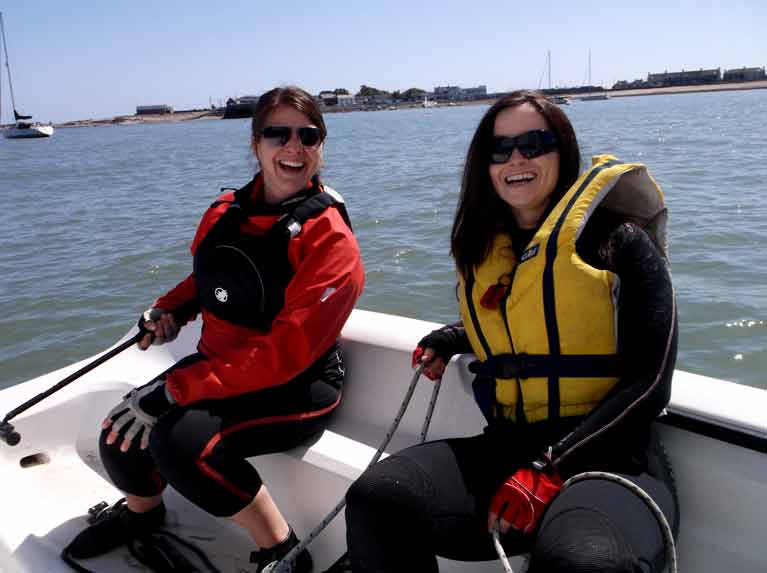 Brid Grimes and Cera Slevin at Just Sailing
Brid Grimes and Cera Slevin at Just Sailing
Some keelboat owners also joined in. We have now reached the stage where we rarely have to go begging feverishly for skippers to help out. Volunteers say they enjoy the experience of passing on their skills and helping grow membership.
“It's also a great source of crew” says keelboat owner Paul Harrison who regularly takes newbies aboard. Fin Kelleher is a keen dinghy racer but helps with Just Sailing because he also enjoys sailing in a relaxed environment.
All Just Sailing sessions end with free coffee and cake where new members can get to know each other as well as meet existing members. During inclement weather we retreat indoors to expand on some theory issues (“just why is it too windy to go sailing today?” or, “exactly how do the tides work around here?”).
“For anyone getting into sailing, the presence of experienced sailors is hugely beneficial,” said newcomer Dermot McNevin. “It's also a great opportunity to try out different types of sailing,” said Kate Kitzgerald.
One unexpected consequence of Just Sailing was a trickle of existing members, including spouses of boatowners, who asked to join our program. "All the pennies suddenly fell into place," dramatically announced announced one owner' s spouse who had sailed with her husband for years and still felt bewildered until she spent a morning in a Wayfarer with us. We were also joined by some Oppie mums and dads infected with the sailing bug by their children.
The only proviso for participation is membership of the club although the first two years is usually on a much reduced incentive subscription (as little as €160 for the first year at 2018 rates). The project has led to a steady increase in membership.
“Just Sailing demystified sailing for me as a novice,” said Magnus Kelly. “The enthusiasm of everyone was infectious.”
“I loved the fact that you can get into a boat and sail without having to complete a rigid number of classes beforehand,” said Jayne Grimes. “It fosters a very engaged approach to learning.”
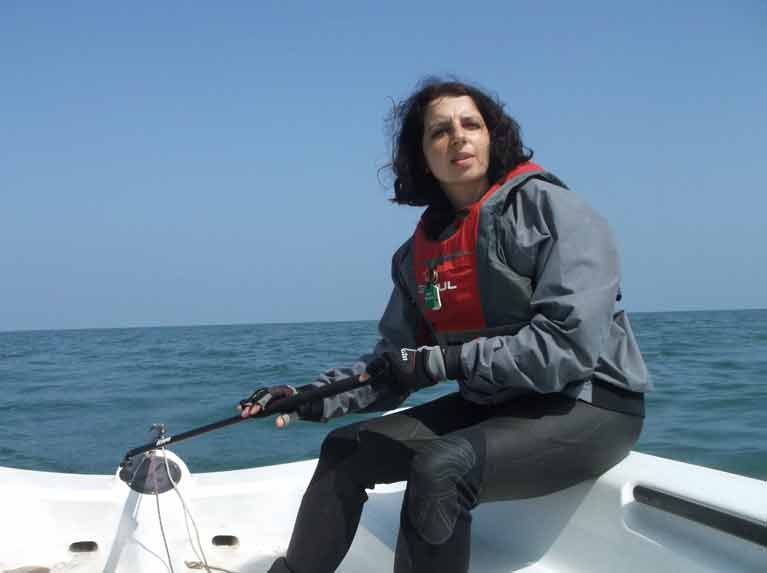 Natalia Pacios tries her hand helming at Just Sailing
Natalia Pacios tries her hand helming at Just Sailing
Natalia Pacios met her husband at Just Sailing. She says it is also a great way of “gathering knowledge on sailing at your own pace”, as well as “having some adventures to nearby harbours”. She has also sampled racing as a crew.
“Lovely to leave a busy week behind and indulge in an activity that is time-consuming with plenty of heavy hauling and knots yet nostalgic and romantic,” said Ben Schazman.
“Just Sailing is flexible enough to cater for all learning speeds and is fantastic fun,” said Joe O'Coigligh.
Check out the Just Sailing Facebook page here or contact [email protected] for more information
Skerries ex-Pat is “Sailor of the Year” in Darwin, Australia
Conor Byrne remembers his best sailing in Ireland as being in Mermaids at his home port of Skerries writes W M Nixon. But for some time now he has been in the most tropical part of Australia in Darwin, and the best sailing there is in the Australian “winter” in July. It was July 18th to 25th when they staged the 2018 Australian Tasar Nationals, and Byrne and his crew Kieran Shortz were best of the locals at fourth overall in the very hot international fleet.
The 14ft Tasar was designed by Frank Bethwaite of Sydney (father of 49er designer Julian) in 1975. Conceived as the simplest possible two-person boat aimed at inter-generational crewing setups, she doesn’t use a spinnaker but nevertheless has proven an enduring design, with closely-monitored licensed builders in Singapore and Canada.
The Tasar offers straightforward sailing within a well-organised class, and the 45th Nationals at Darwin saw two boats under IRL numbers - in addition to Byrne and Shortz, there was a Sydney IRL crew who turned out to be Killian Sargent from Clontarf crewed by his wife Yvonne Murray from Tipperary.
In the end, it was father-and-daughter crew of Rob and Nicolle Douglass from New South Wales who won overall, picking up their 8th National Title. And after all that was done and dusted, the many visitors packed up their boats, and Darwin Sailing Club returned to its regular year round programme.
But even with a 12-month season, there has to be an end-of-year awards ceremony, and it was staged just recently, with Conor Byrne as MC. In theory, he knew everything that was about to happen. But somehow his clubmates kept it a complete secret from him that, at the end, he and Kieran Shortz were to be declared DSC’s “Sailors of the Year”……
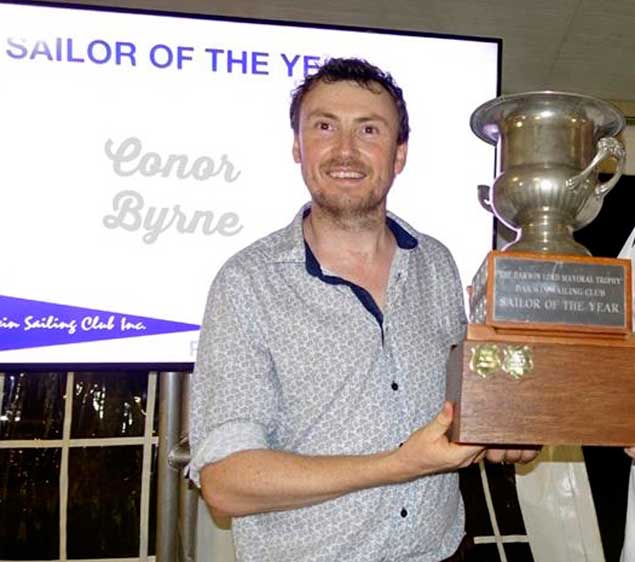 Gotcha! Conor Byrne looking gobsmacked after he was surprised by the Darwin SC “Sailor of the Year” award
Gotcha! Conor Byrne looking gobsmacked after he was surprised by the Darwin SC “Sailor of the Year” award
Skerries Ramps up for Mermaid National Championship
Skerries Sailing Club looks back on its strong historical roots with the Dublin Bay Mermaid class in preparation for hosting this year’s National Championship writes Susan Roundtree
This year’s Dublin Bay Mermaid National Championship is being hosted by Skerries Sailing Club from the 5th to the 11th of August. Sailing starts with a practice race on Saturday the 5th and will continue with 6 days Championship racing over the following week from the 6th to the 11th. In total there will be 10 races for the Championship as well as one Crew’s Race.
Shore side activity will be in Skerries Sailing Club where sailors with their families and friends will be welcomed by Commodore Kieran Branagan and all the team involved with running the event. The event rules require the boats to be kept on moorings for the duration of the competition which will be a spectacular sight in the harbour during the week with ample opportunity for spectators and supporters to view racing. Mermaid Week is unique among dinghy fleets as it has a week-long National Championship with a vibrant social and entertainment calendar to match what is usually top-notch, highly-competitive racing. This year marks the 85th anniversary since this classic dinghy design was first presented to the Committee of Dublin Bay Sailing Club by yacht designer John Breslin Kearney.
Mermaids have a very long association with Skerries which has hosted the Championship on eleven previous occasions, for the first time in 1970 and most recently in 2012. This year, in light of the special anniversary and a resurgence of interest in the class, the club is really ramping up efforts to get as many boats as possible out on the race course and Mermaids from Rush, Dun Laoghaire and Foynes are all already confirmed to join Skerries boats. The news of two recently restored Mermaids in Clontarf (Ferga and Maeve) has been warmly welcomed by Mermaiders who hope to see these boats back out racing in Club and Championship events very soon!
The coveted Mermaid Perpetual Trophy will go to the overall winner in what is known as a very demanding and difficult title to win. It takes the form of the Little Mermaid of Copenhagen by Danish sculptor Edvard Eriksen and is cast in bronze, mounted on a wooden plinth which records all the Championship winners since 1953. The current holder is Sam Shiels of Skerries who won the Championship in Howth last year in his Mermaid Azeezy (no. 189). As it happens the 3 main class trophies all went to Skerries boats last year with Brian McNally, in Gentoo (no.186) winning the Daphne Trophy (silver fleet), and Shay O’Toole, in Dolphin (no.182), winning the Designer Trophy.
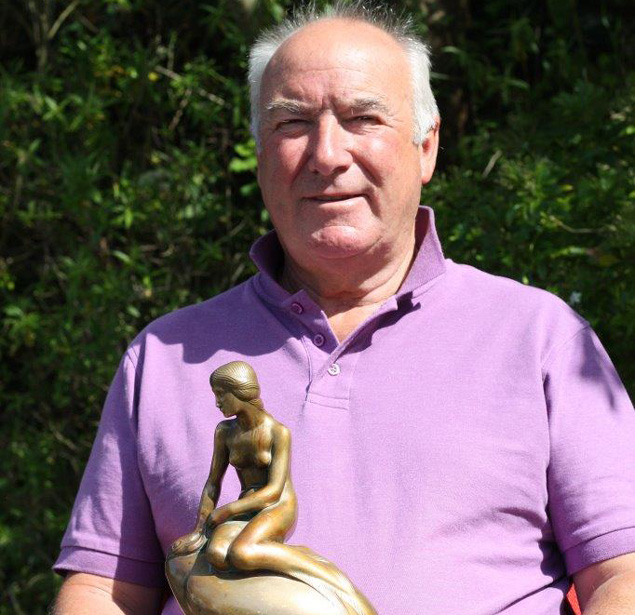 Sam Shiels, the 2016 National Champion with the coveted Mermaid Perpetual Trophy. Photo: Ross Galbraith
Sam Shiels, the 2016 National Champion with the coveted Mermaid Perpetual Trophy. Photo: Ross Galbraith
The Mermaid Perpetual Trophy mentioned above was first presented to the class in 1952 by Norman Hodgson, a founding member of the Mermaid Sailing Association who was also Commodore of Skerries Sailing Club in 1952 and 1953. His own mermaid Rosalie (no. 81) was named after one of his daughters and was one of six boats (nos. 80 – 85) built in the first ever amateur boatbuilding class run by the City of Dublin VEC in what was then known as the Barkyard (later Redmond’s Coal Yard) on the South Strand in Skerries. The remarkable enthusiasm involved in this endeavour gave impetus to the growth of the Mermaid class. The Barkyard itself had originally been the location for the ‘tanning’ or ‘barking’ of the sails of traditional working boats in order to preserve them – the tannin being derived from the bark of the oak tree. The former drying sheds were used for the boat building classes. The names of those early boat builders are synonymous with the history of sailing in Skerries and include; Joe Acton. Kit & Joe Fox, Bobby Carey & Jim Dempsey, Ollie Murray, Matt & and Joe Boylan. Their instructor was Joe Murphy, a member of a well-known boat-building family in Ringsend.
After five years, the return of the National Championship event to Skerries Sailing Club is being warmly welcomed by local members and the community which is not surprising considering how strong its historical ties and links are to the class. This weekend the club will also be hosting its annual ‘Skerries Regatta’ across Saturday and Sunday (the 15th & 16th). Many Mermaids are expected to take part as it is an excellent practice opportunity in advance of the main event.
History credits: The Dublin Bay Mermaid – a history 1932-2000, Paul Smyth, 2001
Annual Mermaid Prizegiving Dinner Continues to Grow
This year marked the third consecutive year that the Mermaid Sailing Association held a stand-alone Prizegiving Dinner event to properly acknowledge the winners of the sailing season just gone. Now normally held around February time, this event gives a fantastic opportunity for the class to close out the sailing season just gone and look forward to the one shortly coming up. On the evening of the 18th of February, with the club fully decked out and over 80 people sitting down for a fantastic three course meal provided by the team at Skerries Sailing Club, this year’s Prizegiving dinner followed the success of the 2 years previous and the night was thoroughly enjoyed by all.
Kieran Branagan, Commodore of Skerries Sailing Club gave some nice opening words expressing how excited the club is to host this year’s Mermaid National Championship on what is the 85th Anniversary for the class. With at least 2 races per day planned over a full 6 days racing (7 if you count the practice race), this year’s National event is promising to give a fantastic week full of top class racing and entertainment making for the perfect week’s holidays for true sailing nuts!
Brian Mc Nally of Skerries Sailing Club also gave a fantastic opening speech as part of his newly appointed position as the Mermaid Class Captain for Skerries. He recalled back to one of his first ever Mermaid Championships where he was eager to please the skipper and let’s just say there were a few learning curves! The Mermaid fleet are known just as well for their excellent social scene and comradery as they are for their racing and Brian’s story was testament to this fact as he recalled how this event was also where he first laid eyes on his now wife, Valerie! The speech got the room into a really positive and “humorous” mood which followed through for the rest of the awards, making for some very interesting speeches. It’s clear from the smiles on everyone’s faces in the pictures just how much fun everyone actually had on the night.
A summary of the prizes awarded on the night are as follows:
The Skipper Clarke Memorial trophy which is awarded to the winners of the National Yacht Club Regatta or combined clubs Dun Laoghaire Regatta was presented belatedly to 134 Jill for 2014 and 2015. There was no race in 2016.
The Skipper Clarke Memorial trophy being awarded by MSA President Des Deane to 134 Jill, Paul Smith, Anne Smith and Pat Mangan from the Royal Irish Yacht Club, Dun Laoghaire.
The Mermaid National Championship cups were awarded as follows:
• The Rockabill Cup, Championship Race 1, 189 Azeezy
• The Dorene Models Cup, Championship Race 2, 77 Tiller Girl
• The North Bull Cup, Championship Race 3, 189 Azeezy (Not presented as this cup’s whereabouts are unknown)
• The Mavis Cup, Championship Race 4, 77 Tiller Girl
• The Rush (Carthy) Cup, Championship Race 5, 189 Azeezy
• The Bailey Cup, Championship Race 6, 123 Vee
The Designer’s Tankard which goes to the best championship boat where the top 2/3 of boats from the previous Championship are excluded went to 182 Dolphin helmed by Shay O’Toole with his crew Seamus Murray and Pierce Benyon.
The Designer won by 182 Dolphin, Shay O’Toole
The Daphne Cup which goes to the best championship boat where the top 1/3 of boats from the previous championship are excluded was won by 186 Gentoo helmed by Brian McNally with crew Valerie McNally and Keith Rochford.
The Daphne won by 186 Gentoo, Brian McNally
Along with the main class trophies and cups, the official ISA medals (which were all beautifully engraved and customized) were also awarded for 1st, 2nd and 3rd place overall. Bronze Medals went to Jonathan O’Rourke, Carol O’Rourke and Tom Murphy from 77 Tiller Girl who finished 3rd overall in the 2016 Mermaid National Championship held at Howth Yacht Club.
Bronze ISA medals awarded to Jonathan O’Rourke, 77 Tiller Girl
Silver went to 131 Wild Wind helmed by Paddy Dillon and crew Johnny Dillon and Mo Dillon for finishing 2nd place overall at the 2016 National Championship, a fantastic result for the Dillons having won the National Championship the year previous in 2015.
Silver medals won by 131 Wild Wind
And the number one spot for overall National Champions 2016 went to 189 Azeezy helmed by Sam Shiels with crew Con Bissett and Eoin Boylan. Needless to say they are truly delighted with their Gold ISA medals and the beautiful Mermaid trophy and were the stars of the night taking the top prize in their home club.
Gold ISA medals awarded to overall 2016 National Champions 189 Azeezy
The growing, continued success of the event is proof of the great positive work that is being done in the class with some new boats and members joining and Skerries campaigning to get 35 boats at the Nationals this year. It’s fantastic to see all the hard work and volunteerism starting to pay off. Everyone is now looking forward to the Mermaid season ahead which kicks off with club racing in May and the first official Championship event being held at Foynes Yacht Club on the 3rd and 4th of June for the Munsters.
The MSA would like to thank everyone who came along and supported the night making it so enjoyable. MSA President Des Deane and Hon Secretary Paul Smith did a great job hosting the awards and handing out the prizes. Thanks also to Ross Galbraith for providing the photos and of course to Skerries Sailing Club for putting on such an enjoyable event.
New members are always welcome to the Dublin Bay Mermaid class If you would like to inquire about getting involved or even coming out for a sail on one of these beautiful classic boats, please don’t hesitate to get in touch with Secretary Paul Smith on [email protected].
Skerries Sailing Club Programme Tells Us When The Tidy Towns 2016 Win Was Assessed
Anyone involved in assessing national sailing contests such as the Mitsubishi Motors “Club of the Year” or the Afloat.ie “Sailor of the Month” awards will be able to tell you it’s much better to do such work by stealth if at all possible, because ideally the adjudicators should be able to get a realistic overview of the contenders in a totally independent frame of mind writes W M Nixon.
Nevertheless when somewhere you know very well and have a great liking for receives the popular SuperValu TidyTowns National Award, as Skerries had done this week after 30 years of serious trying and 57 years after first entering the contest, it’s fascinating to tease out the machinations of the judging process.
For sailors, Skerries is a real fresh air sort of place which is ideal for dinghy championships, and Skerries Sailing Club is well able for events large and small, while at the same time being sacred territory for the Mermaid Class – Skerries sailor Sam Shiels is the current Mermaid National Champion. But even though its harbour dries, it is popular with cruising keelboats too, although the crowded if somewhat exposed anchorage can be distinctly rolly in certain conditions.
 As place unto itself….with its attractive mixture of islands and the harbour on a peninsula, Skerries is unique
As place unto itself….with its attractive mixture of islands and the harbour on a peninsula, Skerries is unique
But while it is hoped that in due course Fingal County Council will lead the way in providing Skerries with a proper harbour, for now Skerries is as it is. And as far as the judging committee in the National Tidy Towns is concerned, Skerries is just fine. In fact, it is so “just fine” that it’s the tops, Ireland’s pace-setter in civic pride and a totally litter-free approach, SuperValu TidyTowns Supreme Champion 2016.
Certainly we’ve been aware of the steady up-grade in recent years, whether visiting by land or sea, and have been particularly impressed with the work done in improving Skerries’ interesting selection of thatched cottages – the “hairy houses” as our kids used to describe them. But whereas in times past the hairy houses sometimes let things run free, in recent years they’ve been becoming very trim, while the town generally seems to have used up about half of Ireland’s annual consumption of fresh paint.
It’s all good news. And the final cherry on the cake is that the Judging Committee made their crucial visit to Skerries when a sailing event was in full swing. According to their report, the adjudicators were in Skerries “during a boating event when there were thousands of visitors about”, yet still the place was being kept blessedly tidy and litter-free.
Looking back over the year and knowing when Skerries is at its humdinger best, we’d say that this was during the Bacharach-sponsored GP14 Irish & Masters Championship from August 27th to 29th, when Tim Corcoran & Brendan Brogan from Sligo won overall, while Hugh Gill from Sutton was runner-up and Masters winner with Conor Twohig as crew, racing in a truly all-Ireland fleet.
As this Drone footage courtesy of the GP 14 Association shows, when it’s summer time in Skerries at its best, then it’s no contest for other contenders in the SuperValue TidyTowns competition.




























